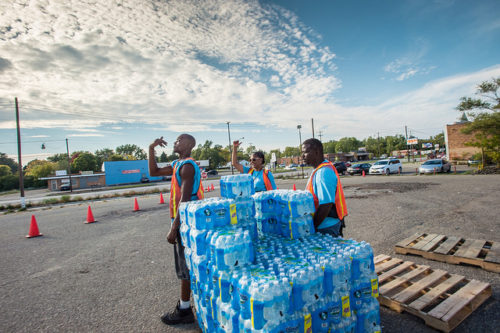
January 18, 2017; New Yorker
Due to the water crisis, the residents of Flint, Michigan do not trust the water coming out of their taps. This has led to major hygiene issues, as some residents refuse to use tap water for bathing or brushing their teeth. Of particularly concern is the use of antibacterial hand gels and baby wipes in the place of handwashing and bathing, which has led to a shigellosis outbreak. While the pipes leaching lead and other hazards into the water have not all been replaced yet, scientists say that simply placing a specific filter onto the head of the tap is enough to ensure the water safe for use.
Problem solved, right? Not quite. After government officials disregarded residents’ concerns when the crisis began, why would Flint residents believe their water is safe now? Mere claims of fact are insufficient after such gross neglect for the well-being of this community. Further, Flint is dealing with systemic issues that are far-reaching and long-lasting.
Enter Maya Shankar and the White House Social and Behavioral Sciences Team. Shankar and her team study how we can use what we know about information processing to influence public policy in ways that benefit society. (For instance, switching from telling veterans they were “eligible for education benefits” to informing them that they had “earned education benefits” led to an increase in enrollment.) Shankar and her team came to Flint to determine whether there are any challenges that can be solved with a behavioral science mindset. What they found was that the immediate issues stemming from the water crisis—those with short-term effects—could be solved through behavioral science techniques.
Sign up for our free newsletters
Subscribe to NPQ's newsletters to have our top stories delivered directly to your inbox.
By signing up, you agree to our privacy policy and terms of use, and to receive messages from NPQ and our partners.
Using a tool called “implementation prompts,” she hopes to encourage families who haven’t already done so to purchase water filters. After church services, the team could offer forms that ask families to indicate when, where, and how they planned on changing their filters. Shankar says, “Sometimes we just need a simple reminder to act on the things we want to act on.” Another example of behavioral tools is “social norming” to encourage washing hands and proper hygiene.
But some issues, like mistrust of the government and the long-term effects of lead poisoning, don’t have clear-cut solutions. Kent Key, director of the Office of Community Scholars and Partnerships at Michigan State University’s College of Human Medicine, discussed how lead poisoning is already impacting the mindset of Flint’s children. The message seems to be that because lead causes cognitive deficiencies, these children are not going to be smart or successful, so why try? Key summarizes the dire situation facing children in Flint:
These kids are internalizing the messages about how the lead is affecting them. If there is a direct correlation between lead exposure and the cognitive ability to handle stressful situations in a reasonable way, and we see more violent trends, can you imagine the pipeline of youth who are going to be going into the corrections system?
Much of the work left to do in Flint is ongoing and evolving. As Dr. Hanna-Attisha, the pediatrician who brought light to the crisis in Flint, aptly said, the work will need to be measured in decades. “This isn’t like a hurricane or a flood you can just clean up.”— Sheela Nimishakavi













